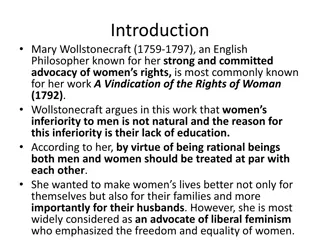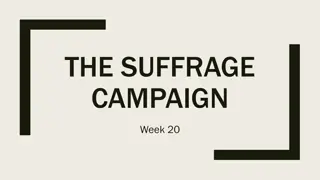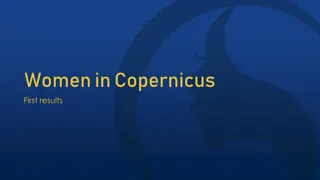Journey of Three Women in 'Vanities'
"Vanities depicts the evolving lives of Kathy, Joanne, and Mary from high school through college and into their late twenties, highlighting themes of fear, vanity, and societal pressures. As the women navigate their ambitions and relationships, their individual struggles with self-centeredness and societal expectations become apparent, ultimately leading to reflections on their unfulfilled lives."
Download Presentation

Please find below an Image/Link to download the presentation.
The content on the website is provided AS IS for your information and personal use only. It may not be sold, licensed, or shared on other websites without obtaining consent from the author.If you encounter any issues during the download, it is possible that the publisher has removed the file from their server.
You are allowed to download the files provided on this website for personal or commercial use, subject to the condition that they are used lawfully. All files are the property of their respective owners.
The content on the website is provided AS IS for your information and personal use only. It may not be sold, licensed, or shared on other websites without obtaining consent from the author.
E N D
Presentation Transcript
Vanities By: Jack Heifner Date of Original Publication: 1975
Awards and Notable Facts The beloved play and by far Jack Heifner s most popular piece was created into a musical entitled: Vanities - A New Musical. It became on of the longest running plays in Off-Broadway history.
Explain the significance of the title in the overall work The title Vanities encapsulates the overall conceit and vanity that the three girls, Kathy, Joanne, and Mary possess. They are far too wrapped up in their own accomplishments to care about anyone else.
Setting: A high school gymnasium in a small town near Dallas during 1963 In the show's second scene, it opens up with the same young women who have gone to the same local college all together. Kathy's posh penthouse in New York City in 1974 The setting of this play is significant because the play showcases multiple settings. Although the settings evolve, the girls remain the constants in the play. We see time pass by and surroundings change; however, the women remain in touch with each other throughout the years.
Themes/Motifs Fear of the unknown- When the girls are in college, Kathy realizes that life will be different once they all graduate and they all split ways. Vanity- The three girls are self centered and only concerned about their own popularity and accomplishments. Societal Pressures- Joanne, Mary, and Kathy all face societal pressures in different ways as we see them progress throughout different stages of their lives. This limits their scope of possibilities. We see this in Joanne when she settles down right after college to be the perfect housewife instead of pursuing her dream career.
Summary Summary Vanities follows the life of three women, Kathy, Joanne, and Mary. We first see the three of them in a gymnasium in Texas, Fall 1963.The three of them are trying to plan the upcoming game and football dance. However, Mary and Joanne struggle to focus as they begin to talk about boys. The second scene opens with Kathy, Joanne, and Mary now in college during a Kappa Kappa Gamma meeting where they discuss the events of the spring semester. Throughout the scene they begin to discuss their plans for the future. At this point we see each girl s individual struggle with where they want to go in life (all having to do with their own vanity). In the third scene, the girls- now about 28 years old- all meet after three or four years of being separated at Kathy s garden apartment. While they begin to catch up, they find that they are not where they pictured themselves being four years ago, as they are all unhappy and unfulfilled with their lives.
The Inciting Incident The Inciting incident occurs in scene two when Kathy, Mary, and Joanne realize that what they re doing is not what they want. Joanne ends up being a music major, not because she wanted to, but it s just what seemed to happen. Mary ends up in interior design, despite having no interest in it, and Kathy wonders what life will be like once they are all separated The Climax The climax occurs in scene three once the women end up drunk off of campagne. Mary and Joanne begin to boast about how great both of their lives are, however this ends up ending in a fight between them as Mary implies that she had an affair with Joanne s seemingly perfect husband.
Conflict The conflict of Vanities surrounds the three main characters, Kathy, Mary, and Joanne, and the ways they cope with their own existentialism (which is a philosophical theory that emphasizes the existence of the individual person as free and responsible in determining their own development through their acts) Whether or not they realize it, they are all living lives that they struggle to find purpose in.
Conflict (cont.) Joanne is a stay at home mother simply because that s all she ever thought she could be. Mary becomes successful by opening an art gallery but we get the sense that although she likes her work, she would be happier elsewhere, maybe in Europe like she had been earlier in the play. And finally, Kathy is the only character who seems to understand her own struggle with existentialism. Kathy always knew what she was going to do, but found she hated it. So when this didn t work out, she moves and continues her struggle to find meaning in her life Society acts as the antagonist, putting pressure on these women to be more than what they are and live the lives they are supposed to . But whether or not they comply, they are unhappy.
Kathy The leader of the group in the beginning.. Very smart and driven. She organizes all the events for the cheer team and the sorority in their younger years but after her experience teaching PE, she realizes that none of it really mattered. She lives in a garden apartment later on in her life and tries to teach herself how to live. She seems to become almost depressed by the time the characters meet again in the last scene.
Mary Mary was always the most rebellious of the group. She never complied to what people expected of her, which is shown when she talks about sneaking out to the drive in behind her mother s back. After college, she goes to Europe and continues to rebel from what society expected of her. Her success in the art gallery comes from a man she slept with in Europe. She is successful and free but she s still unhappy with her life. She represents that even rebelling from society won t get you happiness.
Joanne Joanne is always the most uptight of the group. She always wants to follow the rules, do what is expected of her and she is very much a people pleaser. She represents that following what society expects of you will not make you happy in life either. She married and had kids, and lives what seems to be the picture perfect life. But the audience finds out this is far from the truth when Joanne gets drunk at the end and it is revealed that Mary and Ted are having an affair.
Important Quotes We didn t learn a damn thing other than how to be very, very popular. - Kathy, page 61 It s our responsibility as officers to leave Kappa as we found it. The best sorority on campus - Kathy, page 28 This quote shows that these girls now realize that all the things they used to care about don t matter anymore. That the facade they put on of always being perfect was for nothing. And their lives are the same now as the would have been even if they hadn t been popular. This quote exemplifies the constant need for perfection that these girls face. This is projected onto the activities they participate in. Both in the paths they want to take with their lives and in the way they present themselves
Unfamiliar Terms Goose egg- a zero score in a game Card shop- a store that sells a wide variety of cards and other objects. In the play this is where Mary sells her erotic art. Revlon- a drugstore makeup brand Est e Lauder- an expensive makeup brand Football dance- a dance that occurs after an important football game, similar to homecoming.
Personal Reactions Lily- This play spoke to me personally with the ways the girls dealt with growing up and not knowing what to do with their lives. I ve always been worried about my career and being able to find something I love once I m done with school. This showed me that this is something everyone experiences and that I m not alone in my worries Kinsey- When i heard the synopsis of this play, it sounded really interesting. However, when reading the play, i found very one-dimensional with very little plot. The girls were all the same and the story became repetitive. My favorite part of the play was Mary s cheer in the first segment of the play. It made me literally laugh out loud! Naomi- When reading the beginning of the play,I found the plot shallow and frankly annoying. As the play progressed I understood that this was intentional to show how girls are expected to act this way. We learn that none of them are truly happy with the life that they have lead. I found the idea of this really interesting as it shows that life isn t what you plan.
Scenes Page 15 TO PAGE 22 PAGE 37 TO PAGE 45 Kathy, Mary, and Joanne discuss what the theme should be for the upcoming football dance Kathy explains to Joanne and Mary that s she s unsure of what life will bring after they all graduate and separate. PAGE 45 TO PAGE Mary, Joanne, and Kathy meet at Kathy s apartment in New York and discuss how their lives have been over the past four years.
Sources Heifner, Jack. Vanities: a Comedy in Three Scenes. Doubleday., 1977. Jack Heifner. Samuel French, https://www.samuelfrench.com/a/1786/jack- heifner/.























